Judy is the mentor for the Northwestern University rocketry team, NUSTARS. In April 2013, Judy traveled down to Huntsville Alabama to help the team at the NASA sponsored Student Launch Initiative competition. SLI teams are charged with the goal of building a rocket, engineering a science project into the rocket and launching the rocket and science project to a height of 1 mile. NUSTARS came the closest ever to the 1 mile mark, achieving 5286 feet.

THUNDER ROCKET CLUB
Thunder Rocket Club of the Chicago Waldorf School Takes 4th Place!
Out of 33 Teams at the 2011 Rockets For Schools Class I Competition

Thunder Rocket Club Takes Sheboygan By Storm!
 Or, rather, a storm took Sheboygan during the annual Rockets For Schools competition on May 20 and 21. But the launch continued even in the pouring rain, and the event was a fun experience for the Thunder Rocket Club and the other 50 teams that came to Sheboygan for the two day science fair and rocket launch.
Or, rather, a storm took Sheboygan during the annual Rockets For Schools competition on May 20 and 21. But the launch continued even in the pouring rain, and the event was a fun experience for the Thunder Rocket Club and the other 50 teams that came to Sheboygan for the two day science fair and rocket launch. The first day included a presentation of the science project that the team had put into the payload of their rocket. TRC chose a very sophisticated, challenging and unique payload project. The Rockets For Schools folks said they had never seen anything like our design. The team managed to mount three wind turbines onto the outside of the rocket - a major engineering challenge! As Augie, one of our payload specialists, noted, "its not easy to mount a straight axle on a curved surface." And more difficult still to ensure that it stays mounted in a vehicle travelling over 330 mph!
The purpose behind the turbines was to collect the energy from the air force during acceleration of the rocket. The original plan was to turn the energy into electricity, but the generators proved too heavy for the constraints of the competition (and for the constraints of the laws of aerodynamics - the weight restriction was set by the parameters of rocket stability). So, the team did what good scientists everywhere do and redefined the scope of the project to make it more achievable. The team measured the amount of energy in terms of RPMs of the turbines. They used a bicycle speedometer on one of the turbines to give them the data to calculate the RPMs. A video camera inside the payload allowed them to read the speedometer and to directly count the revolutions of the turbine. They then calculated the amount of volts and amps that could be produced from this movement. They predicted that they would obtain 3000 volts in flight, which would give 7.5 watts of power.
The launch of the 6 foot tall rocket took place on the second day of the event. In typical Rockets For Schools fashion, the rocket was launched into Lake Michigan. The Coast Guard retrieved the rocket from the water. Fog kept the Coast Guard from taking their boats out, so the launch was delayed a few hours. But when the fog cleared, we were the second rocket to go, so we beat the rain. The rocket roared off the pad on a Cesaroni I285 motor. Before the launch, we were a bit anxious because the turbines could possibly have adversely affected the stability of the rocket. But the rocket flew straight as an arrow! The video showed that the turbines worked exactly as intended, spinning freely to collect the energy from the acceleration throughout the flight. When the rocket hit the water, however, the plastic turbines shredded down to the wheel-core. So, the payload is not re-usable. But it worked! A successful launch!
Says club member Lulu, "After working so hard on the rocket and preparing the presentation, it felt good to represent our school with our beautiful rocket. It was also interesting to see other school's rockets and payload projects, and to find out that so many people in the Midwest alone were interested in rocket science."
Thunder Rocket Club rocket roars off the pad:
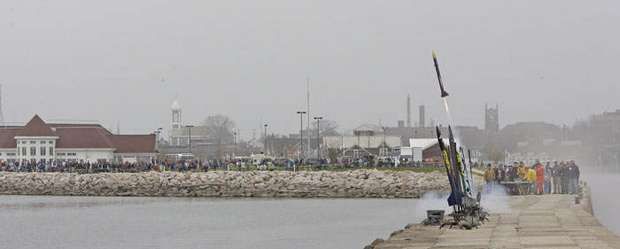
At the start of the event, before the rocket goes off to the RSO (Range Safety Officer):
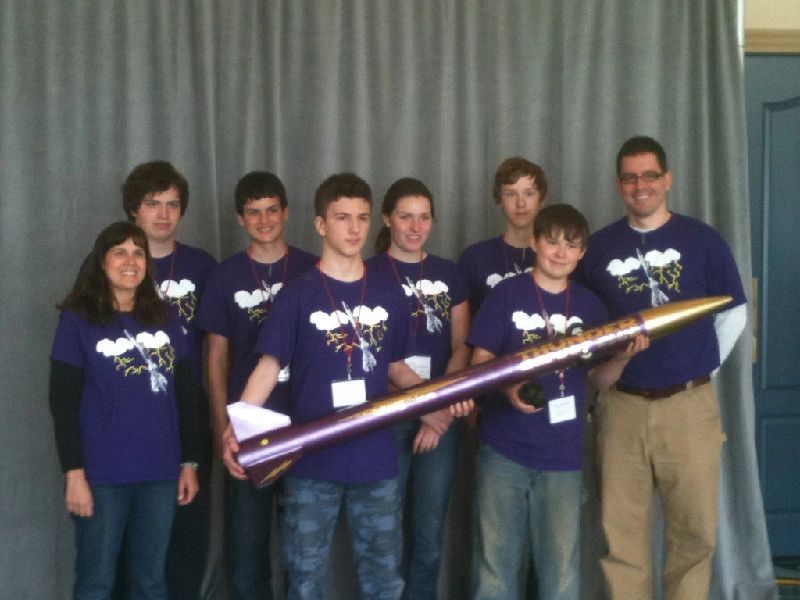
The presentation of the science project:
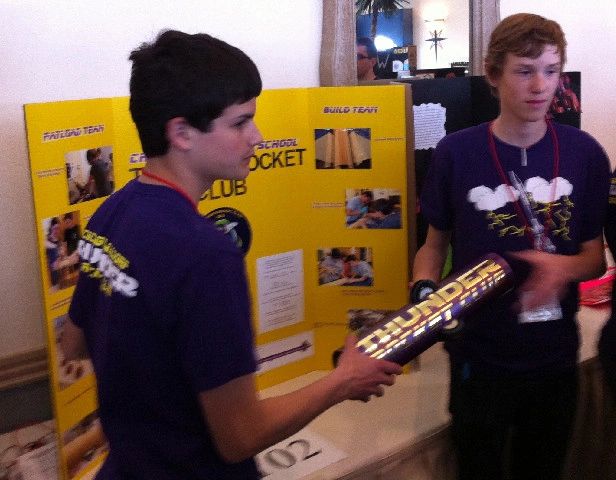
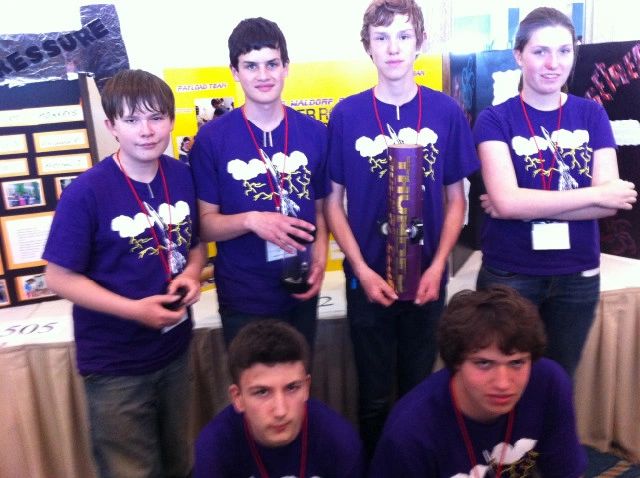
The teams's mission patch: A wind turbine and recycling symbol for renewable energy. The shuttle is launching out of Sheboygan.
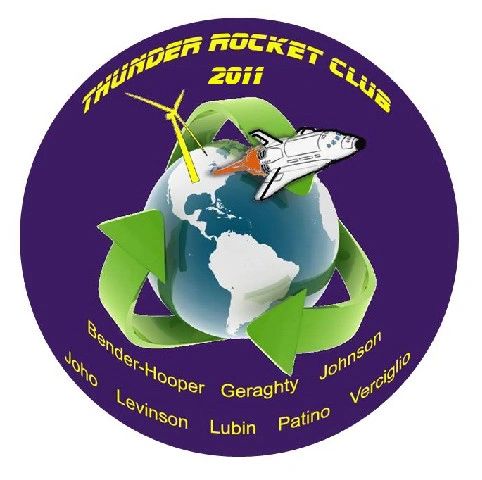
Astronaut Mike Foreman gave a humorous and enlightening talk, at the Spaceport Sheboygan exhibits:

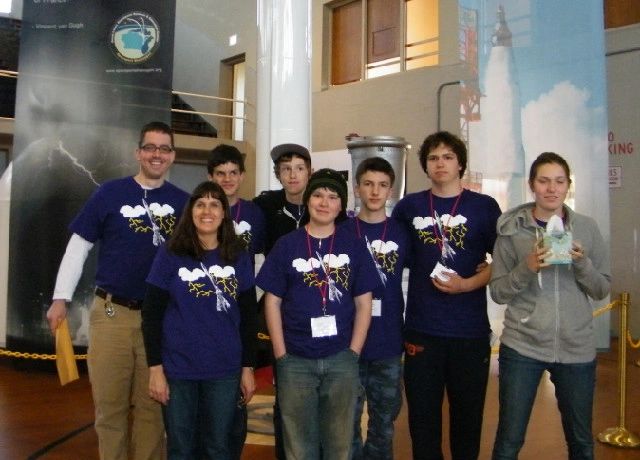
At the RSO table, inserting the payload and prepping the rocket for launch:



Loading the rocket onto the pad:
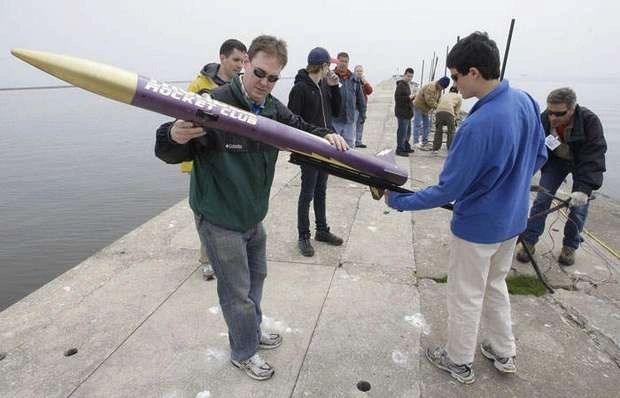
Broken wheels due to water landing:
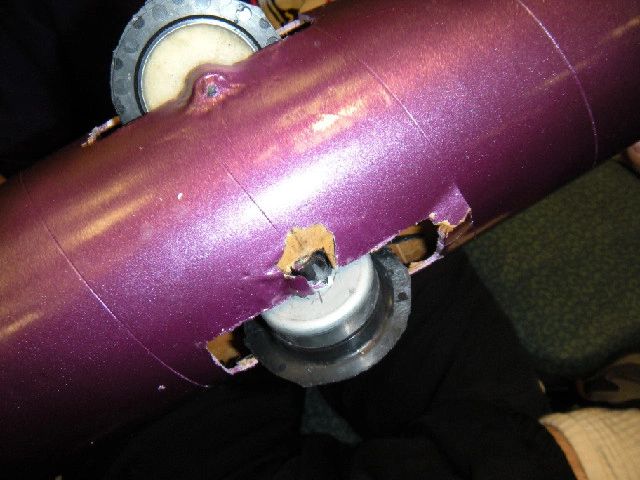
Day after celebration launch (for the purpose of getting a good photo!):

Before the launch: Construction and Payload Design
Payload team, led by Mr Gleichauf: Jackson, Augie and Lulu
 It was a major engineering challenge to mount the turbines on the outside of the rocket. The original design used one wheel, mounted mostly inside. But simulations in RockSim and advice from experienced rocketeers convinced the team that three symetrically mounted wheels would provide better aerodynamics. Since the payload tube was too small for three internally mounted wheels, they mounted the turbines half way inside and half way outside. That meant mounting a straight axle to a curved surface.
It was a major engineering challenge to mount the turbines on the outside of the rocket. The original design used one wheel, mounted mostly inside. But simulations in RockSim and advice from experienced rocketeers convinced the team that three symetrically mounted wheels would provide better aerodynamics. Since the payload tube was too small for three internally mounted wheels, they mounted the turbines half way inside and half way outside. That meant mounting a straight axle to a curved surface.The wheels that eventually became the turbines were originally parts in a centrifugal fan or "squirrel cage fan". The team disassembled the fans and re-purposed the wheels. They mounted an axel and ball bearing into the center of the wheels by filling the space with foam and epoxying the axel into the foamed space. This was very careful work, because one drip of misplaced epoxy would have froze the ball bearings and prevented the wheels from spinning.

Then, the team cut slots in the side of the rocket and mounted the ball bearing unit into the slots:


We took care to ensure a good bond between the ball bearing unit and the body tube. We used special high temp, high strength epoxy mixed with chopped carbon fiber to encapsulate the ball bearing (being ever so careful so as not to get epoxy on the ball bearing!). Even so, the attachment came loose a bit on the drive to Sheboygan. We had to do some on-site repairs.

The project took a great deal of analyzing and calculating. The predictions relied on computer simulations of the rocket using RockSim.

A"wind tunnel" test was also used to calculate the predictions. Below is a view of the inside of the payload during the test. The speedometer reads the speed, but the RPMs can also be calculated manually by counting the rotations of the turbine.


Video of wind tunnel test:
Construction Team, led by Mrs Lubin: Helena, Alex, Jimmy, Gregory and Cheyenne
Construction team did a great job building and painting the rocket. They used an advanced construction technique to attach the fins in a way that provides for extra strength, over and above the typical strength for a rocket of this type. We could launch this rocket on a much bigger motor if we wanted to!


They sanded and sanded and sanded . . .

The whole team, with their mid-power rocket:
Congratulations, Thunder Rocket Club!

Past Club Achievements: Mid-Power Rockets
In December, 2010, the Thunder Rocket Club took on Midpower rockets! The club built and launched an all fiberglass rocket that is 2 feet tall and 1.5 inches and diameter. With a 29mm motor tube, it can take engine sizes from E to I. In the video below, we launched the rocket on an E20 motor. Yes, we braved the cold and snow, all for the sake of science. Photos by Bill Johnson. Video by Judy Lubin.


Before moving up to mid-power rockets, we began with model rockets (motor sizes A-D). Each club member built their own Quest Payloader One rocket. We launched them on Oct 15 on B and C engines.





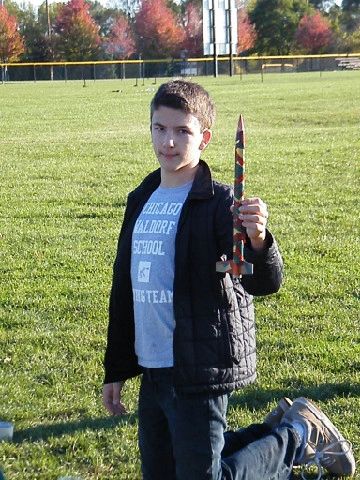




Successful Cert Launches at Clubs First Official Meeting!
Saturday, August 28, 2010 marked the first official meeting of the Thunder Rocket Club. We met at Richard Bong State Recreation Area in Wisconsin and joined a launch hosted by WOOSH (Wisconsin Organization of Spacemodelling Hobbyists).

First order of business was Level 1 certification tests. Over the summer, Jackson mentored Mr Gleichauf and Mr Trevillion in the building of high power rockets. Both teachers built a Wildman Jr rocket from a kit by Wildman Rocketry. The rockets are all fiberglass and are each 2.1 inch diameter and 5 feet tall. They have a 38mm motor mount take will take engines from G up to J.




The finished Level 1 cert rockets, above, belong to (from front to back): Mr Trevillion, Jackson (built last September) and Mr Gleichauf.

Mr. Trevillion launched first on an I-180 Skidmark (sparky). The rocket roared off the pad shooting sparks as it went. It deployed (let out its parachute) perfectly, and landed right near the pad. The rocket was in perfect order, and the cert was earned!

Next, it was Mr. Gleichauf’s turn. He launched on an I-303 blue streak. Again, a perfect launch. It shot straight up to a magnificent height (he didn’t have altimeter, but he predicted about 6000 feet). The rocket opened up and deployed its parachute just as it was supposed to.

Since it went higher than Mr. T’s we knew we would have a longer walk. But after a few minutes, we lost signal on the radio tracker. That and the fact that we saw it heading towards the lake could only mean one thing! We searched all around the lake (including through the bramble infested woods) just in case, but finally abandoned the quest under the assumption that the rocket was, indeed, in the lake. The certification process requires that the rocket be inspected after launch, so Mr. G could not earn his cert. We all left disappointed.
But, the next day, Jackson, Augie and Mrs Lubin returned to the launch field only to be greeted, beyond all expectations, by WOOSH club member Jay Rietz holding Mr. G’s soaking wet rocket! Jay saw the nose cone sticking up a few inches out of the lake, jumped in and swam over it to it (which is not advised, because it’s more of a swamp than a lake). He pulled the rocket out of the muck at the bottom of the lake and brought it back to the pads. The rocket was in perfect order, not even damaged by the water (its fiberglass). So, Mr. G earned his cert, too!
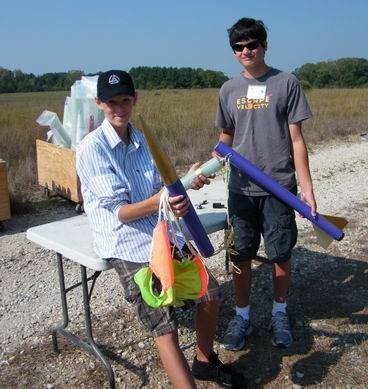
Congratulations to Mr T and Mr G and welcome to high power rocketry!
Jackson and Mrs Lubin launched our 2 stage rocket once on Saturday and once on Sunday. It took quite a while to prep, and only Vlad, his dad Oleg and Mr. T stuck it out on Saturday to watch. It was quite a show!


Alex also launched a nice rocket on an F motor. And, Vlad a lunched a rocket that he built at the launch field.
Overall, we had a great time!
Build and Fly Drag Race
The Build and Fly Drag Race was the unofficial first event of what would become the Thunder Rocket Club. The Lubins hosted the CWS 7th grade Model Rocket Build and Fly Drag Race on May 2. It was a blast! Almost everyone in the class came, along with some friends. Ms Vaca and Mr Gleichauf helped out. In just over an hour, the group built 18 rockets. We launched them in two groups of 9 each.
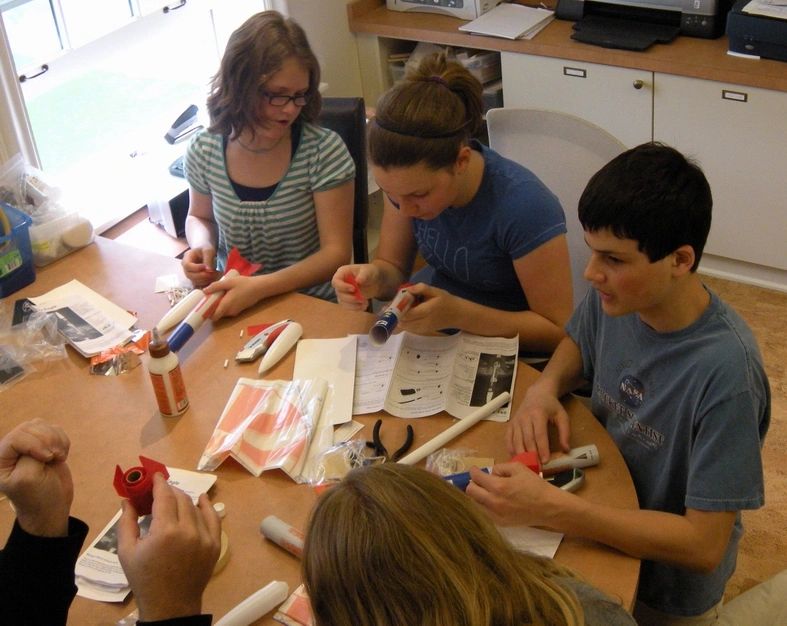



Photo credit to Bill Johnson
